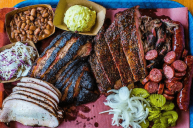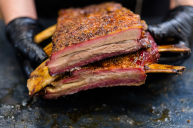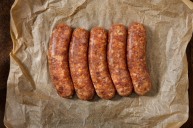Texas is inarguably the barbecue state. With millions of square miles of prime BBQ real estate, it's only natural that its regions will differ in style and taste, just like the United States. Even if you narrow your selection down to sausage, things will still vary wildly. Sausage country starts in what people consider the "sausage capital" of Elgin where you'll find a German-influenced style of links.
Videos by Wide Open Country
Begin traveling southbound, however, and you'll begin to notice things beginning to resemble spicy, Creole cooking. Away from the legacy of smoked brisket in the Texas Hill County, East Texas hot links reign supreme, especially in the Hot Link Capital of Texas: Pittsburg. So what is a hot link?
East Texas 'Links'
Once you get to East Texas, you'll run into one of the other best-known styles of Texas Sausage: East Texas hot Links. Sometimes they're also called "links","juicy links," "homemade links," "garlic bombs," or "grease balls." Whatever their name, these Beaumont-style, all-beef sausages have a long tradition in the African American communities of east and south Texas.
Similar to Italian sausage, they feature coarsely ground beef that is stuffed full of garlic, paprika, chile powder, and lots of trimmed fat. The best hot links, however, always include a mixture of pork butt and ground beef for optimal taste.
Most notably, unlike most Texas sausages, the beef casing is usually too tough to chew so many people cut it open and squeeze out the fragrant filling onto a piece of bread which they then douse in barbecue sauce. This is not a traditional hot dog, though white bread perfectly sops up the juicy leftovers. In many ways, it's very similar to boudin.
At Rhea's Hot Links in Tyler, the fresh sausage is baked, not fried, and use natural pork casings, though hog casings are also common. Some purists, however, insist that you must also eat the casing to enjoy the full experience.
Where Did This Spicy Idea Come From?
These heavily-spiced links have their origins in preservation and poverty. Like other inexpensive specialties, East Texas links originate from the need to avoid wasting prime cut scraps. That means enterprising chefs ground up the trimmings, fat, and offal alike. For over a century, Pittsburg hot links have earned their reputation for deliciousness.
They then combined this grind with a variety of strong spices before stuffing it into a tough casing. Bay leaves, red pepper, cayenne pepper, garlic powder, and black pepper will make an appearance in some family recipes. If the meat was slightly past its prime, chefs would use a heavy hand with the spices to cover up any unpleasant taste.
Today, of course, the liberally spiced sausages are carefully balanced and blended to ensure a wider appeal. However, for those who are unfamiliar with the style, even these gentler, modern interpretations will be an explosive experience for your unaccustomed tongue.
On the second bite though, you'll be ready and find that the uniqueness is what makes these links so irresistible.




